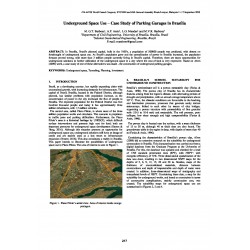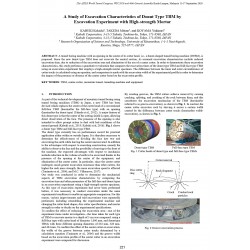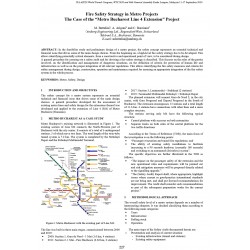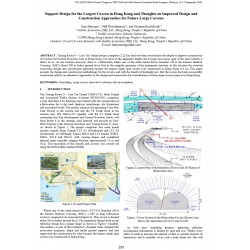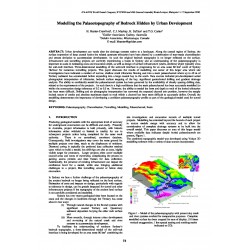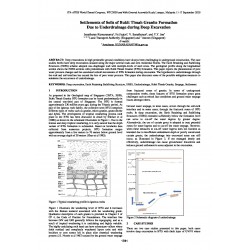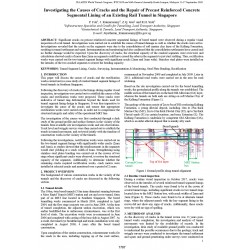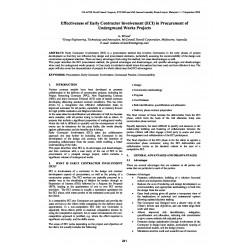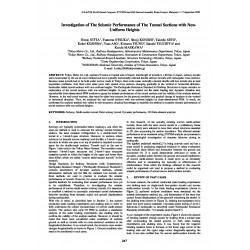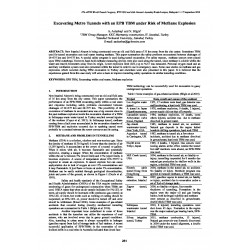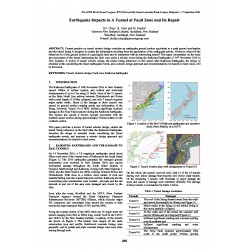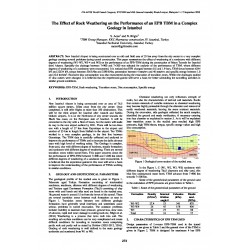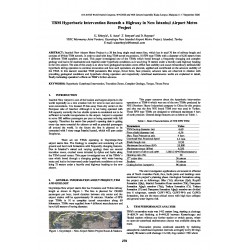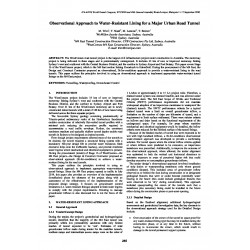No document
Search & filter
Search for a publication
Search & filter
Papers from WTC and ITA conferences have been made available as PDF documents.
ProceedingsThere are 1984 documents.
List of endorsed conferences
-
WTC
World Tunnelling Congress
-
Underground Space Use - Case Study of Parking Garages in Brasília
Abstract: In Brasília, Brazil's planned capital, built in the 1950's, a population of 500000 people was predicted, with almost no forethought of underground space use. As Brazil's population grew and the centralization of power in Brasília increased, the population forecast proved wrong, with more than 3 million people currently living in Brazil's capital. Therefore, there are many opportunities for...
0,00 € -
A Study of Excavation Characteristics of Donut Type TBM by Excavation Experiment with High-strength Mortar
Abstract: A tunnel boring machine with an opening in the center of its cutter head, i.e., a donut-shaped tunnel boring machine (DTBM), is proposed. Since the new donut type TBM does not excavate the central section, its assumed excavation characteristics include reduced excavation time, due to reduction of the excavation area and elimination of the use of a center cutter. In order to demonstrate these...
0,00 € -
Fire Safety Strategy in Metro Projects The Case of the "Metro Bucharest Line 4 Extension" Project
Abstract: In the feasibility study and preliminary design of a metro project, the safety concept represents an essential technical and financial issue that drives some of the main design choices. From the beginning on, a high-level fire safety strategy has to be developed. This allows identifying potentially critical elements, from a constructive and operational point of view, to be considered during...
0,00 € -
Support Design for the Largest Cavern in Hong Kong and Thoughts on Improved Design and Construction Approaches for...
Abstract: Tseung Kwan O – Lam Tin Tunnel project comprises 2.22 km dual two-lane road tunnels developed to improve connectivity of Central and Eastern Kowloon Area in Hong Kong. For most of the alignment length, the average excavation span of the main tunnels is about 16 m. In one location however, there is a bifurcation where one of the main tunnel drives branches off to the Eastern Harbour Crossing,...
0,00 € -
Modelling the Palaeotopography of Bedrock Hidden by Urban Development
Abstract: Urban development can vastly alter the drainage systems native to a landscape. Along the coastal region of Sydney, the surface expression of deep coastal basins the related upstream tributaries have been altered by a combination of man-made channelisation and stream deviation to accommodate development. As such the original bedrock topography is no longer reflected on the surface....
0,00 € -
Settlements of Soils of Bukit Timah Granite Formation Due to Underdrainage during Deep Excavation
Abstract: Deep excavations in high permeable ground conditions have always been challenging in underground construction. The case studies herein have deep excavations situated along the major arterial roads and next residential blocks. The Earth Retaining and Stabilizing Structures (ERSS) scheme adopted was diaphragm wall with multiple-levels of steel struts. The geological profile along the longitudinal...
0,00 € -
Investigating the Causes of Cracks and the Repair of Precast Reinforced Concrete Segmental Lining of an Existing Rail...
Abstract: Significant cracks on precast reinforced concrete segmental linings of bored tunnel were observed during a regular visual inspection of a rail tunnel. Investigations were carried out to establish the causes of tunnel damage as well as whether the cracks were active. Investigations revealed that the cracks on the segments were due to the consolidation of soft marine clay layer of the Kallang...
0,00 € -
Directional Drilling for Tunnel Investigation and Associated Testing Techniques
Abstract: This paper examines the suitable directional drilling options available for tunnel site investigations. It examines the different drilling methods, borehole survey systems and testing that may be conducted within the hole for lithology, ground fluid and geomechanical parameters. The use of open hole drilling coupled with suitable borehole geophysics is compared with core drilling. The issues of...
0,00 € -
Effectiveness of Early Contractor Involvement (ECI) in Procurement of Underground Works Projects
Abstract: Early Contractor Involvement (ECI) is a procurement method that involves Contractors in the early phases of project development so that they can influence key design and procurement decisions, particularly assessing the constructability of the design and construction equipment selection. There are many advantages from using this method, but some disadvantages as well. This paper describes the...
0,00 € -
Investigation of the Seismic Performance of the Tunnel Sections with Non-Uniform Heights
Abstract: Tokyo Metro Co. Ltd. operates 9 routes in Capital area of Japan; total length of tunnels is 1.66 km. In Japan, subway tunnels were constructed by the cut & cover method and have typically horizontally oriented double cell box tunnels with rectangular cross sections. Because some tunnels had to be built under narrow roads in Tokyo, there exist some vertically oriented double cell box tunnels...
0,00 € -
Excavating a Metro Tunnel under a Lake with an EPB TBM Used for Istanbul 3th Airport
Abstract: The metro will make its way to the new Istanbul Airport earliest by 2021. There will be two lines, one with a length of 37 km and the other 35 km. There are few lakes left after mining activities carried out along the Metro Line which cause tremendous difficulties during tunnel excavation. This paper summarizes the performance of an EPB TBM and difficulties encountered and precautions taken...
0,00 € -
Excavating Metro Tunnels with an EPB TBM under Risk of Methane Explosion
Abstract: New Istanbul Airport is being constructed over an old coal field area of 35 km away from the city center. Sometimes TBM used for tunnel excavation cuts coal seams bearing methane. This paper summarizes the safety problems encountered between chainages of 24+375 km and 24+575 km. A special safety program is used during tunnel excavation. For safety reasons, methane sensors were placed upon TBM...
0,00 € -
Earthquake Impacts to a Tunnel at Fault Zone and Its Repair
Abstract: Current practice on tunnel seismic design considers an earthquake ground motion equivalent to a peak ground acceleration and the tunnel lining is designed to sustain the deformation resulting from the application of the earthquake actions. However, what will the behaviour be of the ground motion of a geological fault and its interaction with an intersecting tunnel? This paper concentrates on...
0,00 € -
The Effect of Rock Weathering on the Performance of an EPB TBM in a Complex Geology in Istanbul
Abstract: New Istanbul Airport is being constructed over an old coal field area of 35 km away from the city center in a very complex geology creating several problems during tunnel construction. This paper summarizes the effect of weathering of a sandstone with different degrees of weathering (W1-W2, W3-4 and W5) on the performance of an EPB-TBM during the construction of Metro Tunnels for Istanbul third...
0,00 € -
TBM Hyperbaric Intervention beneath a Highway in New İstanbul Airport Metro Project
Abstract: Istanbul New Airport Metro Project is a 38 km long single track metro line, which has in total 76 km of railway length and consists of 69 km TBM tunnels. In order to deal with long TBM tunnel excavations, 10 EPB type TBMs with a diameter of 6,56 meters from 4 different TBM suppliers are used. This paper investigated one of the TBMs which bored through a frequently changing and complex geology...
0,00 € -
Observational Approach to Water-Resistant Lining for a Major Urban Road Tunnel
Abstract: The WestConnex road tunnel project is the largest civil infrastructure project under construction in Australia. The motorway project is being delivered in three stages and is predominantly underground. It includes 33 km of new or improved motorway linking Sydney’s west and southwest with the Central Business District, and the corridor to Sydney Airport and Port Botany. This paper covers Stage...
0,00 €


